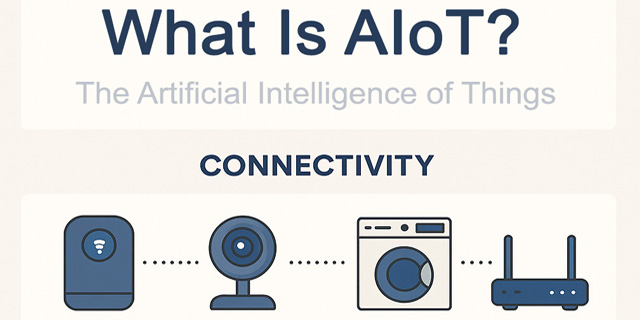In today’s fast-moving tech world, the term AIoT is becoming more and more common. But what does it actually mean? And why should everyday people care about it?
This article offers a simple and clear explanation of AIoT (Artificial Intelligence of Things) — even if you have no technical background.
1. What Does AIoT Mean?
AIoT stands for Artificial Intelligence of Things. It is the combination of two powerful technologies:
- AI (Artificial Intelligence) – allows machines to “think”, learn, and make decisions.
- IoT (Internet of Things) – connects physical devices (like sensors, cameras, or appliances) to the internet so they can collect and share data.
When AI is added to IoT, you get smart systems that don’t just collect data — they understand it and take intelligent actions.
2. How Does AIoT Work?
2.1. Smart Home Example
Imagine you have a smart security camera at your front door. If it’s just an IoT device, it might stream video to your phone. But with AIoT, the camera can:
- Recognize faces of family members.
- Detect strangers and send alerts.
- Record only important activity, not just all the time.
This makes the device not just connected, but intelligent.
2.2. Smart Car Example
A car with AIoT can:
- Detect if the driver is sleepy and issue a warning.
- Adjust air conditioning based on the number of people inside.
- Predict engine problems before they happen.
3. Why Is AIoT Important?
The real power of AIoT is that it turns everyday devices into smart assistants. Here are some key benefits:
- Increased efficiency – Devices can make decisions instantly without waiting for human input.
- Cost savings – Businesses can automate processes, reducing the need for manual work.
- Improved safety – Sensors and AI can detect danger earlier and respond quickly.
- Personalized experiences – Devices can learn user behavior and adapt automatically.
4. Where Is AIoT Used Today?
4.1. Smart Homes
- Lights that turn on when you enter the room.
- Air purifiers that start when pollution levels rise.
4.2. Smart Cities
- Traffic lights that adjust based on real-time traffic.
- Smart trash bins that send alerts when full.
4.3. Healthcare
- Wearables that track heart rate and send health alerts.
- AI tools that help doctors diagnose based on patient data.
4.4. Manufacturing
- Machines that predict when they’ll break down.
- Robots that work alongside humans on the production line.
5. What Makes AIoT Different?
While IoT connects devices, and AI makes decisions, AIoT does both:
- It senses, thinks, and acts.
- It works in real time.
- It learns from data over time to become smarter.
6. Conclusion
AIoT is not science fiction — it’s already around us. From smart watches to city infrastructure, the combination of AI and IoT is transforming the way we live and work.


